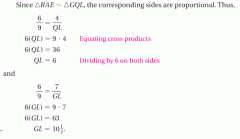![]()
![]()
![]()
Use LEFT and RIGHT arrow keys to navigate between flashcards;
Use UP and DOWN arrow keys to flip the card;
H to show hint;
A reads text to speech;
51 Cards in this Set
- Front
- Back
|
Equilateral
|
All sides are the same length
|
|
|
Isosceles
|
Two or more sides are the same length
|
|
|
Scalene
|
All sides are of different lengths
|
|
|
Obtuse Angle
|
An angle whose measure is greater than 90 degrees and less than 180 degrees.
|
|
|
Acute Angle
|
An angle whose measure is greater than 0 degrees and less than 90 degrees.
|
|
|
Quadrilateral
|
4 sides
|
|
|
Pentagon
|
5 sides
|
|
|
Hexagon
|
6 sides
|
|
|
Heptagon
|
7 sides
|
|
|
Octagon
|
8 sides
|
|
|
Nonagon
|
9 sides
|
|
|
Decagon
|
10 sides
|
|
|
Dodecagon
|
12 sides
|
|
|
Sum of the Angle Measures of a Triangle
|
m(∠A) + m(∠B) + m(∠C) = 180 degrees
|
|
|
Formula for how many triangles a shape can be divided into
|
Each shape has n sides; each shape can be divided into n-2 triangles
|
|
|
Figuring the sum of angles of shapes other than triangles
|
where n= # of sides; (n - 2) • 180 degrees
|
|
|
Area of a Parallelogram (formula)
|
B=Base; (B • H)²
|
|
|
Area of a Triangle (formula)
|
0.5 • B • W
|
|
|
Trapezoid
|
A polygon with four sides, two of which, the bases, are parallel to each other.
|
|
|
Area of a Trapezoid (formula)
|
0.5 • h • (a + b)
a = length of top line b = base |
|
|
Angle
|
A set of points consisting of two rays.
|
|
|
Diameter
|
A line through the middle of a circle.
|
|
|
Radius (definition)
|
A segment with one endpoint on the center and the other endpoint on the circle.
|
|
|
Diameter (formula)
|
d = 2 • r
|
|
|
Radius (formula)
|
r = d ÷ 2
|
|
|
Circumference
|
The distance around a circle.
|
|
|
Circumference (formula)
|
C = π • d
|
|
|
π
|
pi; 3.14; 22/7
|
|
|
Area of a Circle (formula)
|
A = π • r²
|
|
|
Volume of a Cubes & Rectangles (formula)
|
V = l • w • h
|
|
|
Volume of a Circular Cylinder (formula)
|
V = π • r² • h
|
|
|
Volume of a Sphere (formula)
|
V = 4/3 • π • r³
|
|
|
Volume of a Circular Cone (formula)
|
V = ⅓ • π • r² • h
|
|
|
Volume of a Pyramid (formula)
|
V = 1/3 • b • h
|
|
|
Volume of a Prism (formula)
|
V = b * h
|
|
|
What is True of Complimentary Angles
|
• The sum of two angles measurement is 90°.
• Each angle is acute. • If adjacent to each other, they form a right angle. |
|
|
What is True of Supplementary Angles
|
• The sum of the two angles is 180°.
• When the supplementary angles are adjacent, they form a straight line. |
|
|
What is True of Congruent Segments
|
• Have the same size and shape.
• Have the same measurement. • Fit together exactly. |
|
|
≅
|
Congruent
|
|
|
What is True of Vertical Angles
|
• Two non-straight angles.
• Their sides form two pairs of opposite rays. • Are congruent. • Are supplements of the same angle. |
|
|
What is True of Transversal Lines
|
• A line intersects two or more coplanar lines in different points.
• Eight angles are formed. |
|
|
What Is True If a Transvergal Line Intersects Two Parallel Lines
|
• The corresponding angles are congruent.
• The alternate interior angles are congruent. • The interior angles on the same side of the transversal are supplementary. |
|
|
What is True of Congruent Triangles?
|
• Their vertices must be matched so that the corresponding angles and sides are congruent.
• The corresponding sides and angles are called corresponding parts of congruent triangles. |
|
|
Corresponding Angle (definition)
|
Formed when a transversal line crosses two parallel lines.
|
|
|
SSS Congruent Triangles (def)
|
• Side-Side-Side
• Triangles are congruent if all three sides in one triangle are congruent to the corresponding sides in the other. |
|
|
SAS Congruent Triangles (def)
|
• Side-Angle-Side
• Triangles are congruent if any pair of corresponding sides and their included angle are equal in both triangles. |
|
|
ASA Congruent Triangles (def)
|
• Angle-Side-Angle
• If two angles and the included side of a triangle are congruent to two angles and the included side of another triangle, then the triangles are congruent. |
|
|
What is true of Similar Figures?
|
• Have the same shape
• Do not necessarily have the same size |
|
|
What is true of Similar Triangles
|
Their vertices can be matched so that the corresponding angles are congruent and the lengths of corresponding sides proportional.
|
|
|
~
|
Similar
|
|
|
Formula to find lengths of sides in similar triangles
|

|

